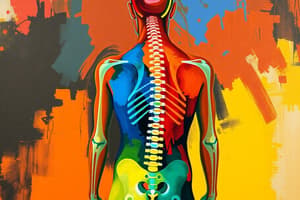Podcast
Questions and Answers
Where should the plumb line fall in a lateral view for the head and neck?
Where should the plumb line fall in a lateral view for the head and neck?
- Through the chin
- Through the ear lobe (correct)
- Above the head
- Behind the ear
The head lies anterior to the plumb line indicates a forward head posture.
The head lies anterior to the plumb line indicates a forward head posture.
True (A)
What is the definition of flattened lordotic?
What is the definition of flattened lordotic?
The plumb line lies anterior to the vertebral bodies.
What may cause excessive lordotic curve according to plumb line posture?
What may cause excessive lordotic curve according to plumb line posture?
What indicates forward shoulders in plumb line posture?
What indicates forward shoulders in plumb line posture?
What are common faults in lumbar vertebrae according to plumb line posture?
What are common faults in lumbar vertebrae according to plumb line posture?
What is genu recurvatum?
What is genu recurvatum?
If the knees have a flexed position, the plumb line falls posterior to the joint axis.
If the knees have a flexed position, the plumb line falls posterior to the joint axis.
Where does the plumb line lie for a forward posture?
Where does the plumb line lie for a forward posture?
Match the fault with its definition:
Match the fault with its definition:
What does a posterior pelvic tilt indicate?
What does a posterior pelvic tilt indicate?
Hallux valgus is the lateral deviation of the first digit at the metatarso-phalangeal joint.
Hallux valgus is the lateral deviation of the first digit at the metatarso-phalangeal joint.
What is claw toes?
What is claw toes?
What is the significance of the plumb line in evaluating sitting posture?
What is the significance of the plumb line in evaluating sitting posture?
Flashcards are hidden until you start studying
Study Notes
Plumb Line Posture Overview
- Plumb line: Vertical line used to assess body alignment, important for evaluating posture.
- The plumb line ideally falls through specific anatomical landmarks at different body segments.
Head and Neck
- Lateral View: Plumb line falls through the ear lobe to the acromion process.
- Common Faults:
- Forward Head: Head positioned anterior to the plumb line.
- Flattened Lordotic Position: Plumb line lies anterior to vertebral bodies.
- Excessive Lordotic Curve: Plumb line lies posterior to vertebral bodies.
Shoulders
- Plumb Line Position: Falls through the acromion process.
- Common Faults:
- Forward Shoulders: Acromion process lies anterior to the plumb line.
Lumbar Vertebrae
- Plumb Line: Falls midway between abdomen/back and slightly anterior to the sacroiliac joint.
- Common Faults:
- Lordotic posture, sway back, flat back.
Knees
- Plumb Line: Passes slightly anterior to the midline.
- Common Faults:
- Genu Recurvatum: Knee hyperextended, plumb line anterior to the joint axis.
- Flexed Knee: Plumb line falls posterior to the joint axis.
Ankles and Feet
- Plumb Line: Lies slightly anterior to the lateral malleolus.
- Common Faults:
- Forward Posture: Plumb line posterior to the body, weight on metatarsal heads, potentially due to dorsiflexion and tight dorsal musculature.
Posterior View Assessment
- Head and Neck: Plumb line bisects the body into left and right halves.
- Common Faults:
- Head Tilt: Head deviates to one side; due to tightness in neck flexors or vertebrae compression.
- Head Rotation: Plumb line deviated due to muscle tightness on one side.
Shoulders and Scapulae (Posterior View)
- Plumb Line Position: Falls midway between the shoulders.
- Common Faults:
- Dropped Shoulder: One shoulder lower; often due to hand dominance or muscle tightness.
- Elevated Shoulder: Higher shoulder due to tightness in upper trapezius.
Trunk Alignment
- Plumb Line: Bisects spinous processes of thoracic and lumbar vertebrae.
- Common Faults:
- Lateral Deviation (Scoliosis): Spinous processes deviate due to muscle length discrepancies and compression of vertebrae.
Pelvis and Hip
- Plumb Line: Bisects the gluteal cleft and posterior superior iliac spines.
- Common Faults:
- Lateral Pelvic Tilt: One side higher, often due to scoliosis or leg-length discrepancies.
- Pelvic Rotation: Plumb line deviates left or right.
Knee Alignment
- Common Faults:
- Genu Varum: Knee joint lateral to mechanical axis; often due to muscle tightness.
- Genu Valgum: Lower limb mechanical axis displaced laterally.
Ankle and Foot
- Common Faults:
- Pes Planus (Pronated): Decreased medial arch; may lead to ligament stretching.
- Pes Cavus (Supinated): High medial arch; associated with muscle tightness.
Anterior View Assessment
- Head and Neck: Lateral tilt and mandibular asymmetry due to muscle tightness and misalignment.
Elbows and Arms
- Plumb Line: Forms a carrying angle of 5° to 15° laterally.
- Common Faults:
- Cubitus Valgus: Lateral deviation over 15°; due to hyperextension or ligament stretching.
- Cubitus Varus: Medial deviation; often caused by fractures or ligament issues.
Sitting Posture
- Pelvic Position: Common faults include excessive pelvic tilting due to muscle tightness or elongation.
Additional Resources
- Video resource for visual understanding: Plumb Line Video
- Detailed guide available at: Plumb Line Information
Studying That Suits You
Use AI to generate personalized quizzes and flashcards to suit your learning preferences.



